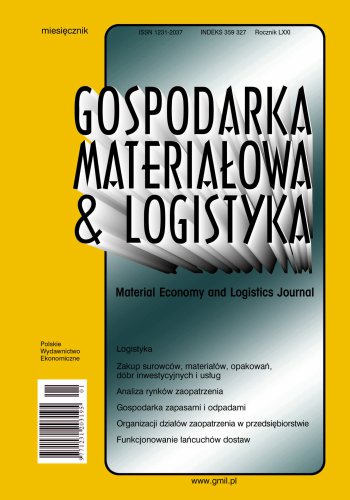Eco-efficiency of the transportation process in the context of reducing greenhouse gas emissions – case study
Global warming is one of the most discussed issues in the context of climate change and refers to the steady increase in the Earth's average air temperature. The main cause of the changes affecting the environment is human activity. The most important task is to reduce atmospheric emissions of greenhouse gases, and one of the most important elements is to change the direction of energy policy – moving away from traditional fossil fuels to zero-carbon energy sources, and according to the author of the publication, systemic changes in the transportation process are also necessary. The article proposes a mathematical model of the eco-efficiency of the transportation process in terms of reducing CO2 emissions into the environment. A detailed analysis of delivery costs was carried out, which in turn led to measurable results of the model in the form of optimal parameters of the studied process (frequency of deliveries and economic size of deliveries) with minimal costs. Existing studies in the field of reducing greenhouse gas emissions from road transport often ignore input data, which is incompatible with a systemic approach. The solutions used in this study integrate both input and output parameters, taking into account economic and environmental aspects, and reflecting diverse global policy practices. The model represents a kind of reengineering of the transportation process and is flexible enough to be applied to most modes of transportation, mainly those that generate the highest CO2 emissions (road transport).
References
References/Bibliografia
Dineen, S. (2014). Multivariate Calculus and Geometry. Third edition. Springer.
Dziubiński, I., & Świątkowski, T. (Eds.). (1980). Poradnik matematyczny. PWN.
Ellabban, O., Abu-Rub, H., & Blaabjerg, F. (2014). Renewable energy resources: Current status, future prospects and their enabling technology. Renewable and Sustainable Energy Reviews, 39, 748–764. https://doi.org/10.1016/j.rser.2014.07.113
European Commission, Secretariat General (2021). Communication from the Commission to the European Parliament, Council, the European Economic and Social Committee and the Committee of the Regions EMPTY: "Ready for 55": achieving the EU's 2030 climate target on the road to climate neutrality (availability: 2.02.2022).
European Commission. (2019). Communication from the Commission to the European Parliament, the European Council, the Council, the Economic and Social Committee Economic and Social Committee and the Committee of the Regions. European Green Deal. Brussels COM (2019), 640.
European Commission. (2020). Communication from the Commission to the European Parliament, the Council, the European Economic and Social Committee and the Committee of the Regions. Economic and Social Committee and the Committee of the Regions. Strategy for Sustainable and Smart Mobility – European Transport on the Road to the Future. Brussels (availability: 9.12.2020).
European Commission. (2021). GHG emissions of all world countries – 2021 Report. https://edgar.jrc.ec.europa.eu/report_2021
Ghosh, A. (2020). Possibilities and challenges for the inclusion of the electric vehicle (EV) to reduce the carbon footprint in the transport sector: A review. Energies, 13(10), 2602. https://doi.org/10.3390/en13102602
Hammond, G. (2007). Time to give due weight to the 'carbon footprint' issue. Nature, 445(7125), 256. http://dx.doi.org/10.1038/445256b
Huppes, G., & Ishikawa, M. (2008). Eco-efficiency and its xsTerminology. Journal of Industrial Ecology, 9(4). https://doi.org/10.1162/108819805775247891
Jursova, S., Burchart-Korol, D., & Pustejovska, P. (2019). Carbon footprint and water footprint of electric vehicles and batteries charging in view of various sources of power supply in the Czech Republic. Environments, 6(3), 38. https://doi.org/10.3390/environments6030038
Koide, R., Lettenmeier, M., Akenji, L., Toivio, V., Aryanie, A., Khodke, A., Watabe, A., & Kojima, S. (2021). Lifestyle carbon footprints and changes in lifestyles to limit global warming to 1.5 °C, and ways forward for related research. Sustainability Science, 16, 2087–2099. https://doi.org/10.1007/s11625-021-01018-6
Secretariat of the Convention on Biological Diversity. (2020). Global Biodiversity Outlook 5.
Simons, P. J., & Cheung, W. M. (2016). Development of a quantitative analysis system for greener and economically sustainable wind farms. Journal of Cleaner Production, 133, 886–898. https://doi.org/10.1016/j.jclepro.2016.06.030
Ślaski, P. (2021). Zapasy materiałowe w systemie bezpieczeństwa narodowego. Wojskowa Akademia Techniczna.
Smyk, S. (2021). Koszty logistyki jako determinanta współczesnych procesów logistycznych. Gospodarka Materiałowa i Logistyka, (4).
Szaruga, E., & Załoga, E. (2022a). Environmental management from the point of view of the energy intensity of road freight transport and shocks. International Journal of Environmental Research and Public Health, 19, 14417. https://doi.org/10.3390/ijerph192114417
Szaruga, E., & Załoga, E. (2022b). Qualitative-Quantitative warning modelling of energy consumption processes in inland waterway freight transport on river sections for environmental management. Energies, 15, 4660. https://doi.org/10.3390/en15134660
Theißen, S., Spinler, S., & Huchzermeier, A. (2014). Reducing the carbon footprint within fast-moving consumer goods supply chains through collaboration. The Manufacturers' Perspective. Supply Chain Management, 50(4), 44–61.
Thompson R. G., Nassir, N., Frauenfelder, P. (2020). Shared freight networks in metropolitan areas. Transportation Research Procedia, 46, 204–211.
UN. (1997). Kyoto Protocol to the United Nations Framework Convention on Climate Change conference of the Parties Third Session Kyoto. Agenda item 5 FCCC/CP/1997/L.7/Add.110
UN. (2015, 12 December). Adoption of the Paris Agreement. Fccc/Cp/2015/L.9/Rev.1.
UNEP. (2020a). Emissions Gap Report 2020. United Nations Environment Programme. https://www.unep.org/emissions-gap-report-2020
UNEP. (2020b). Global Environment Outlook Geo-6 Healthy Planet. Healthy People. Cambridge University Press. https://doi.org/10.1017/9781108627146
Werdmann, T., & Minx, J. A. (2007). Definition of 'Carbon Footprint'. ISA UK Research Report 07-01.
Witkiewicz, Z. (2021). Co po węglu? Głos Akademicki, (9–10), 34.
Zhang, R., & Zhang, J. (2021). Long-term pathways to deep decarbonization of the transport sector in the post-COVID world. Transport Policy, 110, 28–36.
Zhang, R., Fujimori, S. (2020). The role of transport electrification in global climate change mitigation scenarios. Environmental Research Letters, 15(3). https://doi.org/10.1088/1748-9326/ab6658

